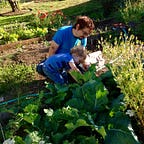Edible “Wild” Plants — A List
Updated frequently — check back often!
Published in
4 min readJun 29, 2015
This list is a resource for both the writers of Invironment and our readers. It’s pretty informal and is meant to catalogue uses, but not to educate on how best to ID the plants in question. Don’t forget: caveat magirus. Don’t eat anything you’re not 100% certain is safe to eat!
This list is informal and not in any particular order (yet). If you have any suggestions, feel free to add via comment.
Ctrl+F to find a plant you’re looking for.
- Dock (Rumex spp.) — Family: Polygonaceae/Buckwheat. Young leaves raw or as potherb. Older leaves stuffed (dolmas). Seeds in crackers. Same family as sorrels. Flavor profile: Primarily sour with a slight bitterness. Mucilaginous when young. French: patience sauvage, rumex sauvage. Quebec French: rhubarbe sauvage (for broad-leafed dock)
- Lambsquarters or lamb’s quarters / fat hen (Chenopodium album) — Family: Chenopodiaceae/Spinach. Leaves raw or cooked. Seeds cooked as quinoa (same family). Flavor profile: “Salty.” Unctuous. Tastes a little like spinach. French: chou gras, chenopode blanc. Quebec French: poule grasse. In English, may also be called “pigweed,” but I prefer this name for amaranth. Easiest to find growing out of very recently disturbed soil.
- Nipplewort (Lapsana communis) — Family: Asteraceae/Sunflower. Young leaves raw or as potherb. Buds pickled. Flavor profile: Very mild, but Asteraceae family, so bitter. Chewy.
- Coltsfoot (Petasites frigidus) — Family: Asteraceae/Sunflower. Young leaves as potherb. Flower stem cooked. *Potentially toxic in large quantities.* Flavor profile: Like a mildly sour celery, pleasantly swampy. Note: this isn’t the same coltsfoot we have in Quebec
- Dandelion (Taraxacum off.) — Family: Asteraceae/Sunflower. Leaves raw or cooked. Flowers for fritters, wine. Roots roasted/stir-fried when tender. Flowers used to make wine. Flavor profile: Leaves bitter. Flowers range from sweet to neutral, but heads can taste like artichokes when cooked. Roots are earthy, coffee-like.
- Stinging Nettle (Urtica dioica) — Family: Urticaceae/Nettle. Leaves cooked as potherb, dried as tea, pulverized as dip/pesto/sauce. Harvest while wearing gloves. Can be used to make a fermented “tea” (purin in French) to spray on plants for vitamins/against insects. Flavor profile: Unctuous, “green.” Note: Not the same as hemp nettle (Galeopsis), which also grows wild in Quebec. “True” stinging nettle is often found growing around old manure piles on farms, has long stringy pendulous white flower stalks.
- Chickweed (Stellaria media) — Family: Caryophyllaceae/Stitchwort. Whole plant raw when young. Cooked at any age. Pulverized for pesto. Flavor profile: Fresh, crisp, sweet.
- Linden (Basswood) tree (Tilia spp.) — Family: Tiliaceae/Basswood. Leaves raw. Blossoms/leaf shoots as a tea. Flavor profile: Crisp, very slightly mucilaginous. Romaine meets okra.
- Sheep sorrel (Rumex acetosella) — Family: Polygonaceae/Buckwheat. Leaves raw. Flavor profile: Crisp, mildly sour.
- Begonia (Begonia tuberosa) — Family: Begoniaceae/Begonia. Leaves, flowers raw. Flavor profile: Citrusy, distinctly sour.
- Licorice fern (Polypodium glycyrrhriza) —Family: Polypodaceae/Ferns. Rhizomes, raw or cooked. Flavor profile: Very sweet, strongly anise/licorice. Harvest notes: Licorice fern is epiphytic, which means it’s usually found growing out of moss.
- Salmonberry (Rubus spectabilis) — Family: Rosaceae/Rose. Berries, raw or as jams, etc. Flavor profile: Mildly sweet, slightly earthier than other wild cluster berries.
- Milkweed (Asclepias syriaca) — Family: Asteraceae/Sunflower. Young flower buds before they have opened. Flavor profile: tastes like broccoli raw, hints of cantaloupe. Harvest notes: Milky white liquid comes from broken stems and in quantity may irritate skin, especially if you have small cuts on your fingers. Plant critical to monarch butterfly life cycle.
- Amaranth — “Pigweed” though it shares this name with lamb’s quarters
- Common Mallow (Malva neglecta) — Family: Malvaceae/Mallow. Leaves, flowers, seed-pods. Raw or cooked. Can be processed into “marshmallow” candy. Flavor profile: Mild, mucilaginous.
- Red Clover (Trifolium pratense) — Family: Fabaceae/Legume. Leaves, flowers, raw in salads. Excess may cause indigestion. Flavor profile: Sweet, crisp.
- Shepherd’s Purse (Capsella bursa-pastoris) — Family: Brassicaceae/Mustard. Seed pods, leaves, raw in salads or potherb. Flavor profile: Spicy, peppery.
- Hawthorn (Crataegus spp.) — Family: Rosaceae/Rose. Fruit, cooked into sauces/soups/jellies. Flavor profile: Slightly sweet. Note: Seeds are toxic.
- Madrone (Arbutus menziesii) — Family: Ericaceae/Heather. Fruit, raw or processed into sauces/jellies. Flavor profile: Sweet to bland.
- Western Red Cedar (Thuja plicata) — Family: Cupressaceae. Leaf tips as tea or processed into jelly/syrup. Flavor profile: Acidic, slightly sweet.
- Cleavers (Galium aparine) — Family: Rubiaceae/Coffee. Young leaves as salad. Older leaves as potherb. Entire plant as tea. Flavor profile: “Green,” crisp. Very slight sweetness when young.
- Elderberry (Sambucus spp.) — Family: Adoxaceae/Elderberry. Flowers for tea. Berries for syrup/jams/wine/medicine. Flavor profile: Sweet. Mild anise/licorice flavor in some berries. Harvest note: Do not eat without proper processing. Blue and black versions should be used. Red berries are reportedly mildly toxic.
- Maple (Acer spp.) — Family: Aceraceae/Maple. Sap for syrup. Blossoms/young leaves raw or cooked/battered. Flavor profile: Sweet.
- Bladder Campion (Silene vulgaris) — Foraging literature says the young leaves are eaten, but the flowers taste good and are beautiful. French: petards.
- Fireweed (Epilobium angustifolium) — Family: Onagraceae/Evening Primrose. Young leaves/flowers raw in salads. Leaves (any age) as potherb. Stalks: peeled, raw or cooked. Shoots cooked as asparagus. Flavor profile: Flowers sweet. Leaves range from mildly sweet to slightly astringent.
- Camas (Camassia quamash) — Family: Asparagaceae. Bulb, fire-roasted. Flavor profile: Very sweet, reminiscent of yams. CAUTION: Poisonous look-alike called “Death Camas,” with white blossoms — virtually indistinguishable when young. Excercise safe plant ID!
- Kousa Dogwood (Cornus kousa) — Family: Cornaceae. Fruit when red and soft in jams, jellies, sauces, etc. Flavor profile: Slightly sweet to flavorless. See also: Pacific dogwood (C. nuttalli) and bunchberry (C. canadensis).
- Chicory (Cichorium intybus) — Family: Asteraceae. Leaves and flowers when young. Root roasted for excellent coffee substitute. Flavor profile: Bitter.
- Salsify (Tragopogon porrifolius) —
- Thistles (Cicerbita spp.)
- Wild Lettuce (Lactuca virosa)
- Japanese knotweed (Fallopia japonica)
- Sweet Clover (Melilotus)
- Pineappleweed
- Mugwort
- Wild mint
- Perennial sow-thistle
